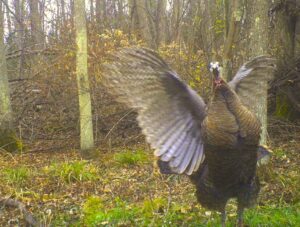By Kennedy Zittel, naturalist
It’s that time of year again when the spotlight is on those once “extinct,” gobbling, snood-covered birds. Wait – what?
 Wild turkeys. It was only recently that we could even see wild turkeys here. The species went extinct in Wisconsin in the late 1800s due to overhunting and habitat loss. In 1976, the Wisconsin Department of Natural Resources (WI DNR) traded with the state of Missouri. In exchange for ruffed grouse, they gave us 29 wild turkeys that were released into Vernon County. Now, you can find them in all 72 counties. But how would you know if one was around?
Wild turkeys. It was only recently that we could even see wild turkeys here. The species went extinct in Wisconsin in the late 1800s due to overhunting and habitat loss. In 1976, the Wisconsin Department of Natural Resources (WI DNR) traded with the state of Missouri. In exchange for ruffed grouse, they gave us 29 wild turkeys that were released into Vernon County. Now, you can find them in all 72 counties. But how would you know if one was around?
(What noise does a turkey’s phone make? Wing wing wing!)
They may not use phones, but turkeys make a variety of calls. We all know the famous gobble gobble, but turkeys can make 28 different sounds including purrs, clucks, cackles, and yelps. They are noisy birds, not only do they make a variety of sounds, but they are also noisy fliers!
(Can a turkey jump higher than the Nature Center? Of course, buildings can’t jump.)
Though turkeys prefer to spend most of their time on the ground, they can fly. Unlike domestic turkeys, wild turkeys can fly for short distances, reaching speeds up to 55 mph! Since they can’t see well at night, they spend the night perched in trees to stay safe from predators.
Other signs that turkeys are around are tracks. They have big tracks, 4-5” long. You can also tell by their scat (poop) who was around. Males leave J-shaped scat while females leave spiral-shaped scat.
Common monikers for turkeys are: males (Toms), females (Hens), juvenile males (Jakes), juvenile females (Jennys), and babies (Poults) – whew! To add to the fun words, they have some uniquely named features too:
Snood: A flap of skin that hangs over a male’s beak
Caruncle: Loose and bumpy skin on a turkey’s head that helps attract a mate
Beard: A tuft of bristly feathers found on the chest of male (and 20% of female) turkey
Wattle: A flap of loose skin that hangs under a turkey’s chin
(What is a turkey’s favorite food? Peach gobbler!)
Though that isn’t what they eat, they probably wouldn’t mind it. They are opportunistic foragers, meaning they will adapt their diet to what food is available. Eating seeds, nuts, berries, grains, grass, roots, invertebrates, small amphibians and reptiles, and even small mammals. This allows them to live in a variety of different environments.
We see turkeys all over the preserve here at Woodland Dunes. We find their tracks, feathers, and scat on our trails. We hear their noisy calls echoing through the woods and prairies, and they are one of the most common animals we see on our trail cameras. Though many people focus on them this week, we enjoy turkeys all year!
photo: turkey caught on Woodland Dunes’ trail camera






